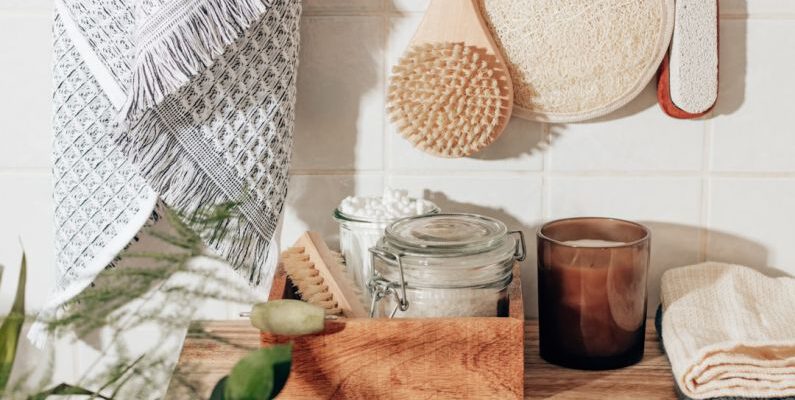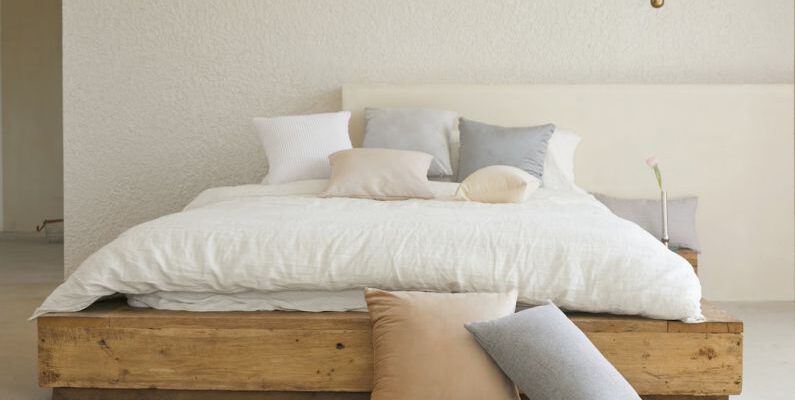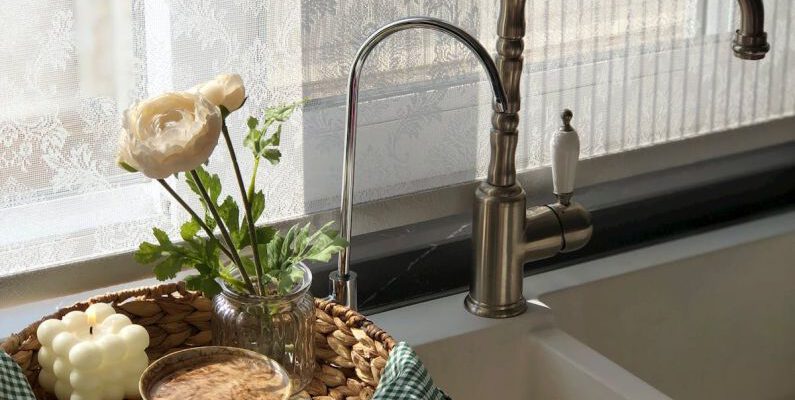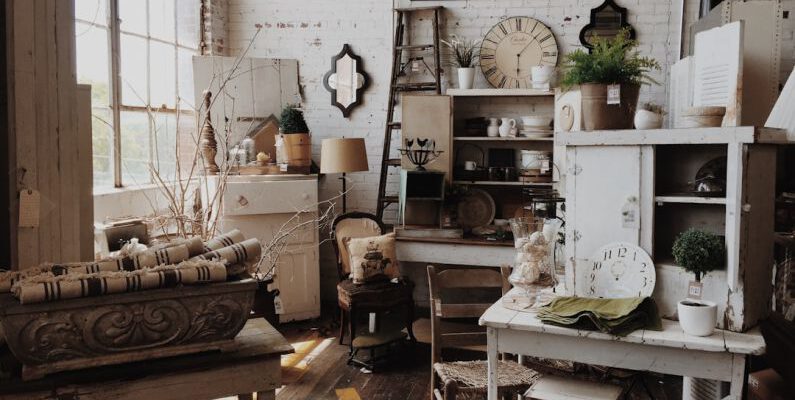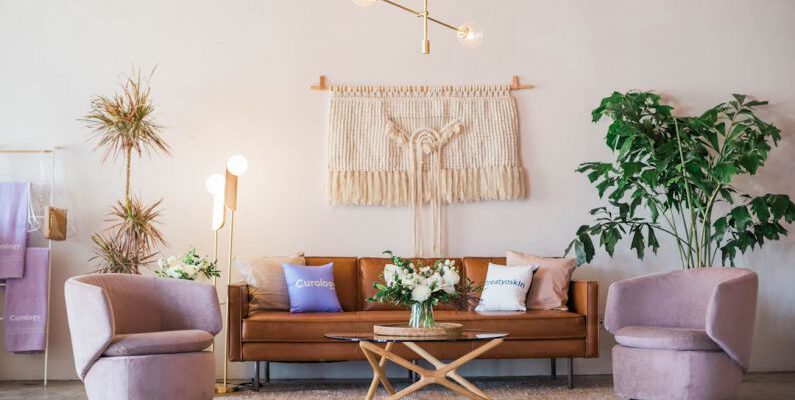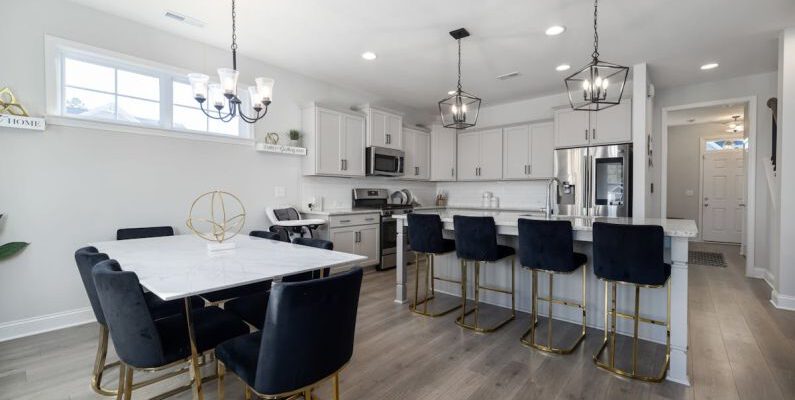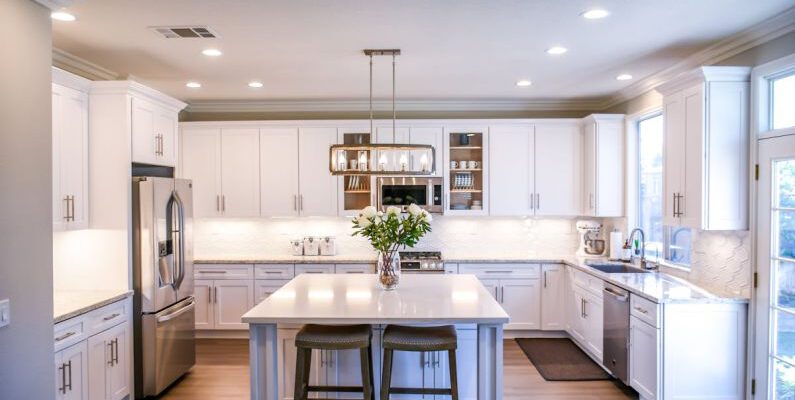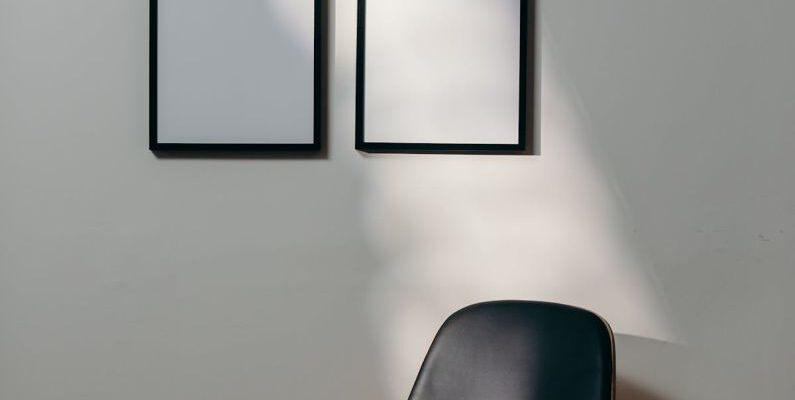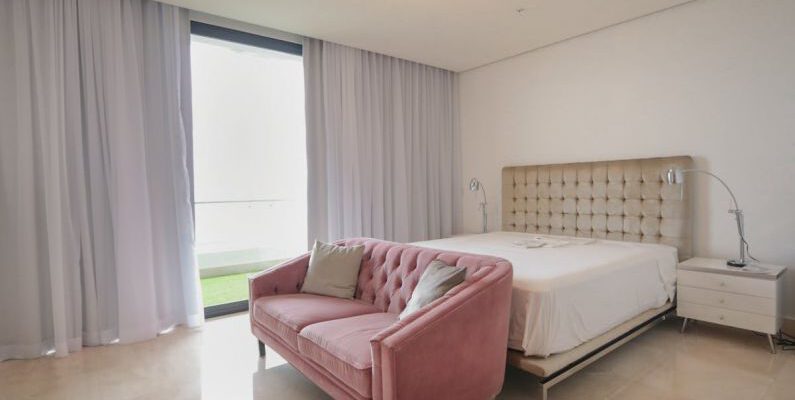In recent years, the focus on sustainability has become increasingly prevalent in all aspects of daily life, including home design. Homeowners and designers alike are now looking for innovative ways to create eco-friendly and energy-efficient living spaces. From incorporating recycled materials to utilizing renewable energy sources, sustainable home design trends continue to evolve. Let's explore some of the latest trends in sustainable home design that are shaping the way we live and build our homes.
Home Decor
In Home Decor
In recent years, minimalist decor has gained significant popularity across various interior design styles. This shift towards minimalism can be attributed to several factors that have resonated with people seeking simplicity, functionality, and a sense of calm in their living spaces. Let's delve into why minimalist decor is becoming increasingly favored by homeowners and designers alike.
The Rise of Minimalism in Interior Design
Minimalist decor is characterized by its clean lines, simple color palettes, and uncluttered spaces. This aesthetic approach focuses on the principle of "less is more," emphasizing the importance of quality over quantity. The rise of minimalism in interior design can be linked to a growing cultural shift towards mindfulness and sustainability. As people seek to simplify their lives and reduce their environmental impact, minimalist decor offers a visually appealing and practical solution.Creating a Sense of Calm and Serenity
One of the key reasons why minimalist decor is gaining popularity is its ability to create a sense of calm and serenity in the home. By eliminating excess clutter and unnecessary decorations, minimalist spaces promote a feeling of openness and tranquility. The clean and uncluttered aesthetic of minimalism allows for better flow of energy and promotes a peaceful atmosphere, making it an ideal choice for those looking to create a relaxing environment in their homes.Embracing Functionality and Practicality
Minimalist decor is not only visually appealing but also highly functional and practical. By focusing on essential pieces of furniture and decor items, minimalist spaces are designed to be efficient and purposeful. This emphasis on functionality means that every item in a minimalist room serves a specific purpose, helping to streamline daily living and reduce unnecessary distractions. In a world where simplicity and efficiency are highly valued, minimalist decor offers a practical solution for those looking to optimize their living spaces.Promoting Mindful Consumption
Another reason for the increasing popularity of minimalist decor is its promotion of mindful consumption. In a society driven by consumerism and materialism, minimalism encourages people to be more intentional about the items they bring into their homes. By prioritizing quality over quantity and focusing on the things that truly matter, minimalist decor advocates for a more sustainable and conscious approach to decorating. This shift towards mindful consumption aligns with the growing awareness of the environmental impact of excessive consumption and resonates with individuals seeking to lead a more balanced and purposeful lifestyle.The Influence of Scandinavian Design
Scandinavian design has played a significant role in popularizing minimalist decor around the world. Known for its simple yet elegant aesthetic, Scandinavian design embodies the principles of minimalism by emphasizing clean lines, natural materials, and a neutral color palette. The timeless appeal of Scandinavian design has inspired many homeowners and designers to adopt a minimalist approach to decorating, leading to a resurgence of interest in minimalist decor across different cultures and design styles.Embracing Minimalist Decor in Your Home
If you're considering incorporating minimalist decor into your home, start by decluttering and simplifying your living spaces. Focus on quality over quantity, choose furniture and decor items that serve a purpose, and opt for a neutral color palette to create a sense of cohesion and tranquility. By embracing the principles of minimalism in your home, you can create a space that is not only visually appealing but also functional, practical, and conducive to a peaceful lifestyle. In conclusion, minimalist decor is becoming more popular due to its ability to create a sense of calm and serenity, promote functionality and practicality, encourage mindful consumption, and draw inspiration from Scandinavian design. By embracing minimalist decor in your home, you can create a space that reflects simplicity, elegance, and a conscious approach to living.
In Home Decor
Farmhouse style homes have soared in popularity in recent years, capturing the hearts of many homeowners with their charming, cozy, and inviting aesthetic. Reflecting simplicity, warmth, and a touch of nostalgia, farmhouse style homes blend traditional elements with modern comforts to create a unique and timeless appeal. If you are looking to infuse your home with the quintessential farmhouse charm, understanding the key elements of this design style is essential. From rustic materials to architectural details, here are the elements that define a farmhouse style home.
Rustic Materials and Textures
At the core of farmhouse style is the use of natural, rustic materials that evoke a sense of simplicity and authenticity. Wood, particularly reclaimed or distressed wood, plays a pivotal role in creating the farmhouse look. Exposed beams, hardwood floors, and shiplap walls are common features that add character and warmth to the interior spaces. Additionally, incorporating other textures such as stone, metal, and natural fibers like jute and linen further enhances the rustic appeal of a farmhouse style home.Neutral Color Palette
A neutral color palette forms the foundation of farmhouse style decor, setting the tone for a serene and soothing ambiance. Whites, creams, beiges, and soft grays dominate the color scheme, creating a backdrop that allows the natural materials and textures to shine. While neutrals are the primary colors used in farmhouse interiors, subtle pops of color in muted tones like sage green, soft blue, or pale yellow can be introduced through accessories and decor items to add interest and depth to the space.Vintage and Antique Furnishings
Incorporating vintage and antique furnishings is a hallmark of farmhouse style, infusing the home with a sense of history and nostalgia. Weathered, worn-in pieces with patina and imperfections contribute to the lived-in and comfortable feel of a farmhouse interior. Mixing old with new, such as pairing a reclaimed farmhouse table with modern chairs or blending vintage textiles with contemporary upholstery, creates a curated look that is both stylish and inviting.Cozy Textiles and Layered Fabrics
To enhance the cozy and inviting atmosphere of a farmhouse style home, the use of soft textiles and layered fabrics is key. Think plush throw blankets, linen drapes, cotton slipcovers, and wool rugs that add warmth and texture to the space. Mixing different fabrics in varying weights and textures creates depth and visual interest while fostering a sense of comfort and relaxation.Architectural Details
Architectural details play a crucial role in defining the farmhouse style aesthetic. Elements such as board and batten siding, gable roofs, dormer windows, and wrap-around porches are characteristic of farmhouse architecture and contribute to its charming appeal. Exposed brick walls, barn doors, and industrial-style lighting fixtures are additional details that can be incorporated to enhance the farmhouse look and feel.Functional and Unfussy Design
Farmhouse style embraces a functional and unfussy approach to design, prioritizing comfort and practicality above all else. Furniture is often sturdy and well-worn, with a focus on pieces that serve a purpose and stand the test of time. Open shelving, farmhouse sinks, and butcher block countertops are common features in farmhouse kitchens, emphasizing utility and simplicity in design.Embracing the Wabi-Sabi Aesthetic
Wabi-sabi, the Japanese philosophy of finding beauty in imperfection and impermanence, aligns seamlessly with the farmhouse style ethos. Embracing the wabi-sabi aesthetic in a farmhouse interior involves celebrating the beauty of aged materials, embracing the patina of time, and cherishing the imperfect and handmade elements that give a space its unique character. This appreciation for the imperfect and the authentic is what gives farmhouse style homes their soulful and inviting allure. Incorporating these key elements into your home will help you create a farmhouse style interior that exudes warmth, charm, and character. By combining rustic materials, neutral colors, vintage furnishings, cozy textiles, architectural details, and a wabi-sabi sensibility, you can transform your living space into a cozy retreat that feels both timeless and modern. Whether you live in a rural farmhouse or a city apartment, infusing your home with farmhouse style elements can bring a sense of comfort and tranquility to your everyday life.
In Home Decor
In today's ever-evolving world of interior design trends, it seems that what goes around comes back around, especially when it comes to vintage decor elements. From mid-century modern furniture to retro color palettes, the charm of vintage pieces is making a significant comeback in contemporary design schemes. But what exactly is fueling this resurgence of nostalgia and how are these elements finding their way back into modern homes?
Nostalgia in Design
The rise of vintage decor elements can be attributed to a collective sense of nostalgia that has swept across the design world. In a time where everything seems to move at a rapid pace, there is a yearning for the simplicity and authenticity of the past. Vintage pieces evoke memories of a bygone era, bringing a sense of comfort and familiarity into our living spaces. Whether it's a retro-inspired armchair or a collection of antique knick-knacks, these elements serve as a link to the past, allowing us to create spaces that feel both timeless and personal.Embracing Sustainability
Another driving force behind the resurgence of vintage decor elements is the growing emphasis on sustainability and eco-conscious design practices. In a society that is becoming increasingly aware of the environmental impact of mass production and consumerism, there is a renewed appreciation for the quality and craftsmanship of vintage pieces. By incorporating vintage items into our homes, we not only reduce our carbon footprint but also give new life to objects that would otherwise end up in landfills. Vintage decor allows us to embrace a more sustainable approach to design, where reuse and repurposing take center stage.Mixing Old with New
One of the key reasons vintage decor elements are making a comeback is the trend of mixing old with new. Designers and homeowners alike are embracing the concept of eclecticism, blending modern aesthetics with vintage charm to create spaces that are unique and full of character. By juxtaposing sleek, contemporary furniture with quirky vintage finds, we can achieve a harmonious balance between the past and the present. This blending of styles adds depth and visual interest to interiors, creating a dynamic and personalized look that transcends cookie-cutter design trends.Adding Personality and Character
Vintage decor elements bring a sense of personality and character to a space that is often lacking in mass-produced, generic furnishings. Whether it's a weathered leather sofa that tells a story of years gone by or a retro lamp that adds a pop of color and whimsy, vintage pieces inject a sense of individuality into our homes. By incorporating these unique finds, we can create spaces that reflect our personal tastes and interests, making a bold design statement that sets our homes apart from the rest.The Timelessness of Vintage
One of the most compelling reasons for the resurgence of vintage decor elements is their inherent timelessness. Unlike trendy pieces that quickly fall out of favor, vintage items have stood the test of time and continue to exude a sense of enduring style and elegance. Whether it's a classic mid-century modern chair or a vintage Persian rug, these pieces possess a quality that transcends fleeting trends, ensuring that they remain relevant and desirable for years to come. By investing in vintage decor, we can create spaces that age gracefully, evolving with us as our tastes and preferences change.Embracing Imperfection
Vintage decor elements celebrate imperfection in a way that modern design often overlooks. From the patina of aged wood to the wear and tear of a vintage mirror, these imperfections add depth and character to a space, giving it a lived-in and inviting feel. By embracing the flaws and quirks of vintage pieces, we can create interiors that are warm, authentic, and full of stories waiting to be told. In conclusion, the resurgence of vintage decor elements can be attributed to a combination of nostalgia, sustainability, eclecticism, and the timeless appeal of these unique pieces. By incorporating vintage finds into our homes, we can create spaces that are not only visually stunning but also meaningful and reflective of our personal style. Whether it's a single statement piece or a curated collection of vintage treasures, these elements have the power to transform our living spaces into havens of warmth, personality, and charm. So, why not embrace the allure of vintage decor and infuse your home with a touch of timeless elegance and character?
In Home Decor
Adding a Personal Touch: The Power of DIY Projects in Home Decor
Home decor is a reflection of one's personality and style, showcasing the unique character of the individuals residing within. While there are countless ways to enhance the aesthetic appeal of a living space, do-it-yourself (DIY) projects have gained significant popularity for their ability to infuse a personal touch into home decor. Embracing creativity and individuality, DIY projects offer a fulfilling and budget-friendly approach to transforming living spaces. Let's delve deeper into the impact of DIY projects on home decor and explore how they can elevate the ambiance of your abode.Unleashing Creativity: Customizing Your Space
One of the most compelling aspects of DIY projects in home decor is the opportunity they provide for individuals to unleash their creativity and showcase their unique style. Whether it's creating handmade artwork, upcycling furniture, or crafting decorative accents, DIY projects allow homeowners to tailor their living environment to their preferences. By incorporating personalized elements into their decor, individuals can create a space that truly speaks to their identity and interests, making it a reflection of who they are.Enhancing Individuality: Standing Out from the Crowd
In a world where mass-produced decor items dominate the market, DIY projects offer a refreshing alternative for those looking to stand out from the crowd. By crafting one-of-a-kind pieces that cannot be found in mainstream stores, individuals can infuse their homes with a sense of individuality and uniqueness. Whether it's a hand-painted mural, a custom-built shelving unit, or a repurposed vintage find, DIY projects enable homeowners to make a bold statement and set their living space apart from cookie-cutter designs.Creating Meaningful Connections: The Joy of Handmade
There is a profound sense of satisfaction that comes from creating something with your own hands, and this sentiment is amplified when it comes to home decor. DIY projects allow individuals to imbue their living spaces with a sense of authenticity and craftsmanship that is often lacking in mass-produced items. Whether it's a quilt passed down through generations, a macrame wall hanging made with care, or a handmade piece of furniture, the personal touch of DIY projects can foster a deeper connection to the home and create a warm and inviting atmosphere for both residents and guests.Expressing Emotions: Infusing Sentiment into Decor
Home decor is not just about aesthetics; it is also a means of expressing emotions and memories. DIY projects offer a unique opportunity to infuse sentimental value into the decor by incorporating personal stories, experiences, and cherished items into the design scheme. Whether it's framing family photos, displaying travel mementos, or creating a gallery wall of children's artwork, DIY projects allow homeowners to surround themselves with reminders of what matters most, creating a space that is not just visually appealing but emotionally resonant.Adapting to Change: Flexibility in Design
One of the key advantages of DIY projects in home decor is the flexibility they offer in adapting to changing tastes, trends, and lifestyles. Unlike store-bought decor items that may quickly become outdated or fall out of favor, DIY projects can be easily modified, updated, or replaced to reflect evolving preferences. Whether it's repainting a piece of furniture, switching out throw pillows, or rearranging wall art, DIY projects empower homeowners to refresh their living space without breaking the bank, ensuring that their decor remains current and reflective of their style.Crafting Memories: The Legacy of DIY Projects
In addition to enhancing the aesthetic appeal of a home, DIY projects have a lasting impact that extends beyond mere decoration. The memories created through the process of crafting and implementing DIY projects become ingrained in the fabric of the home, forming a legacy that can be passed down through generations. Whether it's a handmade quilt that becomes a family heirloom, a DIY renovation project that bonds loved ones together, or a collection of handcrafted items that tell the story of a life well-lived, DIY projects leave a lasting imprint on the home and its inhabitants.Embracing Personalization: Making It Your Own
At the heart of DIY projects in home decor is the concept of personalization – the ability to transform a living space into a reflection of one's unique personality, interests, and experiences. By embracing DIY projects, homeowners can take ownership of their decor and create a home that is truly their own. Whether it's through small, subtle touches or bold, statement pieces, DIY projects offer a canvas for self-expression and creativity, allowing individuals to curate a living environment that resonates with who they are and what they love. In conclusion, DIY projects have the power to add a personal touch to home decor that goes beyond mere aesthetics. By unleashing creativity, enhancing individuality, creating meaningful connections, expressing emotions, adapting to change, crafting memories, and embracing personalization, DIY projects enable homeowners to transform their living spaces into unique, personalized sanctuaries that reflect their identity and values. Whether you're a seasoned crafter or a novice DIY enthusiast, incorporating handmade elements into your decor can elevate the ambiance of your home and imbue it with warmth, character, and soul. So, roll up your sleeves, grab your tools, and let your creativity run wild – the possibilities are endless when it comes to adding a personal touch to your home decor through the power of DIY projects.
In Home Decor
Creating a relaxing home environment is essential for promoting a sense of calm and well-being. One effective way to achieve this is through the strategic use of color. The colors we surround ourselves with can have a significant impact on our mood and overall sense of comfort within our living spaces. By carefully selecting the right colors for your home, you can create a soothing and tranquil atmosphere that promotes relaxation and rejuvenation. In this article, we will explore the best colors for creating a relaxing home environment.
**Soft Blues and Greens**
Soft blues and greens are often associated with feelings of serenity and tranquility. These cool tones can help to create a calming atmosphere in your home, perfect for unwinding after a long day. Blue is known to be a soothing color that can lower blood pressure and heart rate, making it an ideal choice for bedrooms and living areas. Green, on the other hand, is often linked to nature and growth, and can evoke a sense of peace and harmony within a space. Consider using soft shades of blue and green in your home to promote relaxation and create a peaceful environment.
**Neutrals**
Neutral colors such as white, beige, and grey are timeless choices for creating a relaxing home environment. These versatile hues provide a blank canvas for you to work with, allowing you to add pops of color through accessories and furnishings as desired. Neutral colors can help to create a sense of balance and simplicity in your home, which can be especially beneficial for promoting relaxation. Consider using neutral tones on walls, floors, and larger pieces of furniture to create a cohesive and calming space.
**Soft Pastels**
Soft pastel colors such as lavender, blush pink, and soft yellow can add a touch of warmth and tranquility to your home. These gentle hues can create a sense of comfort and relaxation, making them perfect for bedrooms and cozy living spaces. Lavender is often associated with relaxation and stress relief, while blush pink can evoke feelings of softness and femininity. Soft yellow is known to be an uplifting color that can promote happiness and positivity. Incorporating soft pastel colors into your home can help to create a soothing and inviting atmosphere.
**Earthy Tones**
Earthy tones such as terracotta, rust, and ochre can bring a sense of warmth and grounding to your home. These rich colors are reminiscent of nature and can create a cozy and welcoming atmosphere. Terracotta, in particular, is a trending color that can add depth and character to a space, making it an excellent choice for creating a relaxing environment. Rust and ochre tones can evoke feelings of comfort and stability, perfect for creating a sense of sanctuary within your home. Consider incorporating earthy tones into your decor to create a warm and inviting space that promotes relaxation.
**Cool Grays and Soft Whites**
Cool grays and soft whites are classic choices for creating a serene and peaceful home environment. These light and airy colors can help to open up a space and create a sense of freshness and clarity. Cool grays can add a touch of sophistication and modernity to a room, while soft whites can create a clean and calming atmosphere. Consider using cool grays and soft whites in combination with other calming colors to create a cohesive and relaxing environment in your home.
**Conclusion:**
In conclusion, the colors you choose for your home can have a powerful impact on your overall sense of well-being and relaxation. By incorporating soft blues and greens, neutrals, soft pastels, earthy tones, and cool grays and soft whites into your decor, you can create a tranquil and inviting space that promotes relaxation and rejuvenation. Experiment with different color combinations to find the perfect palette for your home, and enjoy the calming effects of a well-designed living environment.
In Home Decor
Open floor plans have become a highly sought-after feature in modern homes, with more and more homeowners opting for this layout over traditional closed-off spaces. The appeal of open floor plans lies in their ability to create a sense of spaciousness, connectivity, and versatility within a home. Let's delve into why open floor plans are so desirable and why they continue to be a popular choice among homebuyers.
Enhanced Social Interaction and Connectivity
One of the key reasons why open floor plans are so desirable is their ability to foster social interaction and connectivity among family members and guests. By eliminating barriers such as walls and doors, open floor plans create a seamless flow between the kitchen, living room, and dining area, allowing people to move freely and interact with one another. This layout promotes a sense of togetherness and makes it easier for individuals to engage in conversations and activities while still being in the same shared space.Natural Light and Airflow
Open floor plans are known for their abundant natural light and airflow, thanks to the unobstructed views and lack of walls that can block sunlight and ventilation. With fewer barriers in place, light can easily penetrate through the space, creating a bright and airy atmosphere. This not only enhances the aesthetic appeal of the home but also contributes to a healthier and more pleasant living environment. The seamless flow of air throughout the open layout also helps in regulating the temperature and maintaining a comfortable indoor climate.Flexibility and Versatility
Another reason why open floor plans are highly desirable is their flexibility and versatility in terms of design and functionality. With a cohesive living space that blends different areas together, homeowners have the freedom to customize the layout according to their needs and preferences. Whether it's rearranging furniture, dividing the space into zones, or incorporating multifunctional elements, open floor plans offer endless possibilities for creativity and personalization. This adaptability allows individuals to make the most out of their living space and create a home that suits their lifestyle.Improved Visibility and Safety
In open floor plans, there are fewer hidden corners and blind spots, which can enhance visibility and safety within the home. Parents can keep an eye on their children playing in the living room while they cook in the kitchen, or guests can socialize in the dining area while still being connected to the main living space. This increased visibility not only fosters a sense of security but also promotes a more inclusive and interactive environment where everyone feels connected and involved.Sense of Spaciousness and Flow
One of the most significant advantages of open floor plans is the sense of spaciousness and flow they create within a home. By removing dividing walls and barriers, the space appears larger and more open, giving the illusion of a grander and more expansive living area. This feeling of openness can make a home feel more inviting, comfortable, and welcoming, allowing individuals to move freely and navigate the space with ease. The seamless flow between different areas also contributes to a more cohesive and harmonious environment, where every part of the home feels connected and integrated.Embracing Modern Living
In today's fast-paced and interconnected world, open floor plans have become synonymous with modern living and contemporary design aesthetics. This layout reflects the way we live and interact with one another, emphasizing the importance of shared spaces, connectivity, and multifunctional living areas. By embracing open floor plans, homeowners can create a home that is not only visually appealing but also conducive to their lifestyle and needs. This modern approach to home design has solidified the popularity of open floor plans and continues to attract individuals looking for a dynamic and versatile living environment.The Allure of Open Floor Plans
In conclusion, the desirability of open floor plans can be attributed to their ability to enhance social interaction, promote natural light and airflow, offer flexibility and versatility, improve visibility and safety, create a sense of spaciousness and flow, and embrace modern living. These qualities make open floor plans a popular choice among homeowners who value connectivity, functionality, and aesthetics in their living spaces. As the demand for open floor plans continues to rise, it is clear that this layout has become more than just a trend but a timeless and enduring feature in modern home design.
In Home Decor
Smart home devices have revolutionized the way we interact with our living spaces. From thermostats that adjust to our preferences to lighting systems that can be controlled remotely, these gadgets offer convenience and efficiency like never before. But can these high-tech tools seamlessly blend into the design of a home without compromising aesthetics? Let's explore how smart home devices can be incorporated into home design to create a harmonious and functional living environment.
Enhancing Aesthetics with Seamless Integration
One of the main concerns when incorporating smart home devices into a design scheme is how to maintain the overall aesthetic of the space. Traditional devices such as thermostats and security cameras can often appear clunky and out of place in a well-designed room. However, with advancements in technology, many smart home devices now come in sleek and modern designs that can complement a variety of interior styles. For example, smart lighting systems like Philips Hue offer a range of customizable options that can enhance the ambiance of a room while seamlessly blending into the design. These devices can be integrated into existing fixtures or installed discreetly to create a cohesive look that doesn't detract from the overall aesthetic.Creating a Connected and Functional Home
Beyond aesthetics, incorporating smart home devices into home design can also greatly improve the functionality and efficiency of a space. From smart thermostats that learn your heating and cooling preferences to automated blinds that adjust based on the time of day, these devices can help create a more comfortable and convenient living environment. By strategically placing sensors and devices throughout the home, homeowners can create a connected ecosystem that responds to their needs in real-time. For example, a smart home hub can be programmed to adjust the lighting, temperature, and music in a room based on the time of day or the occupants' preferences. This level of automation not only enhances the living experience but also helps conserve energy and reduce utility costs.Incorporating Smart Home Devices into Design Elements
To truly integrate smart home devices into home design, it's important to consider them as part of the overall design elements of a space. Instead of treating these devices as standalone gadgets, they should be incorporated into the design scheme from the beginning to ensure a cohesive and harmonious look. For example, smart mirrors with built-in displays can serve as both functional devices and decorative elements in a bathroom or bedroom. Similarly, smart speakers can be strategically placed throughout the home to provide seamless audio integration without compromising the design aesthetic.Maximizing Space and Efficiency with Smart Solutions
Another benefit of incorporating smart home devices into home design is the ability to maximize space and efficiency. For smaller homes or apartments, smart devices can help streamline daily tasks and optimize the use of limited space. For example, smart storage solutions like motorized closets or modular furniture with built-in charging stations can help maximize storage space while keeping the home clutter-free. Additionally, smart appliances such as refrigerators with touch-screen displays or ovens with remote control capabilities can help homeowners make the most of their kitchen space while adding a touch of modernity to the design.Embracing the Future of Home Design
As technology continues to advance, the possibilities for incorporating smart home devices into home design are endless. From voice-activated assistants to integrated home security systems, these devices offer a level of convenience and control that was once unimaginable. By embracing the future of home design and integrating smart devices into our living spaces, we can create homes that are not only beautiful and functional but also efficient and connected. With careful consideration and planning, smart home devices can seamlessly blend into any design scheme to create a truly modern and intelligent living environment.
In Home Decor
In today's fast-paced world, more people are working from home than ever before. With the rise of remote work, it's crucial to have a home office that not only meets your practical needs but also enhances your productivity. Designing a home office that boosts productivity involves creating a space that is conducive to focus, creativity, and efficiency. By incorporating the right elements into your home office design, you can create a workspace that will help you stay motivated and focused throughout the day.
Creating a Functional Layout
One of the first steps in designing a home office that boosts productivity is to create a functional layout. Consider the flow of the space and how you move within it. Position your desk in a way that allows you to easily access the tools and resources you need while working. Make sure your office layout promotes good ergonomics to prevent strain and discomfort. Invest in a comfortable chair and ensure your computer screen is at eye level to reduce neck strain.Natural Light and Proper Lighting
Natural light can have a significant impact on productivity and well-being. Position your desk near a window to take advantage of natural light, which can help reduce eye strain and boost your mood. If natural light is limited, invest in good quality lighting fixtures that provide adequate illumination without causing glare or harsh shadows. Consider incorporating task lighting for focused work areas and ambient lighting for a softer, more inviting atmosphere.Incorporating Plants and Greenery
Bringing nature into your home office can have a positive effect on your productivity and mental well-being. Consider adding plants and greenery to your workspace to improve air quality and create a more inviting environment. Plants can help reduce stress, increase focus, and boost creativity. Choose low-maintenance plants such as succulents or snake plants if you are new to gardening or have a busy schedule.Declutter and Organize
A cluttered workspace can lead to distractions and hinder productivity. Keep your home office organized by decluttering regularly and creating designated storage areas for office supplies, files, and paperwork. Invest in organizational tools such as shelving, bins, and drawer organizers to keep your workspace tidy and efficient. A clean and organized workspace can help reduce stress and improve focus, making it easier to stay productive throughout the day.Personalize Your Space
Your home office should reflect your personality and style to create a space where you feel comfortable and inspired. Personalize your workspace with artwork, photographs, or décor that motivates and energizes you. Choose colors that promote focus and creativity, such as blues, greens, or neutrals. Consider adding personal touches such as inspirational quotes, a vision board, or a favorite plant to make your home office feel like a place where you can thrive.Create a Tech-Savvy Environment
In today's digital age, technology plays a crucial role in productivity. Make sure your home office is equipped with the necessary tech tools to support your work. Invest in a reliable internet connection, ergonomic keyboard and mouse, and a second monitor for multitasking. Keep your tech gadgets organized and charged to avoid distractions and delays while working. Consider investing in noise-canceling headphones or a white noise machine to create a quiet and focused work environment.Maintain a Work-Life Balance
While it's essential to have a home office that boosts productivity, it's also important to maintain a healthy work-life balance. Set boundaries between work and personal time to prevent burnout and maintain your well-being. Create a designated workspace that you can leave at the end of the day to signal the transition from work to relaxation. Take regular breaks, stay active, and make time for activities that bring you joy and fulfillment outside of work. Incorporating these design elements into your home office can help you create a space that boosts productivity and enhances your overall well-being. By focusing on functionality, comfort, and personalization, you can design a home office that supports your work goals and helps you stay motivated and inspired throughout the day. With the right design elements in place, you can create a workspace that fosters creativity, focus, and efficiency, allowing you to achieve your best work from the comfort of your home.
In Home Decor
Creating a luxurious look for your home doesn't have to break the bank. With some creativity and strategic planning, you can transform your living space into a sophisticated sanctuary without spending a fortune. By incorporating a few key design elements and making smart choices, you can achieve a high-end aesthetic that exudes elegance and style. Here are some tips on how to make your home look luxurious on a budget.
Start with a Neutral Palette
One of the easiest ways to give your home a luxurious feel is by sticking to a neutral color palette. Neutral tones such as whites, creams, grays, and beiges create a sense of sophistication and timeless elegance. Paint your walls in a soft, neutral hue to create a clean and cohesive look throughout your space. You can then add pops of color through accessories like throw pillows, rugs, and artwork to add interest and depth to the room.Invest in Quality Furniture Pieces
When it comes to furnishing your home, quality always trumps quantity. Instead of filling your space with cheap, mass-produced furniture, invest in a few high-quality pieces that will stand the test of time. Look for pieces made from durable materials like solid wood or metal, and choose classic designs that won't go out of style. You can also check out thrift stores or online marketplaces for gently used designer furniture at a fraction of the cost.Add Texture and Layers
To create a luxurious look in your home, focus on adding texture and layers to your decor. Mix and match different textures like velvet, silk, wool, and faux fur to create a rich and inviting atmosphere. Layering rugs, throw blankets, and pillows can also add depth and visual interest to your space. Consider incorporating elements like a plush area rug, velvet curtains, or a cozy cashmere throw to enhance the luxurious feel of your home.Incorporate Metallic Accents
Metallic accents are a simple yet effective way to elevate the look of your home. Whether it's a sleek chrome lamp, a glamorous gold mirror, or a chic brass coffee table, adding metallic elements can instantly add a touch of luxury to any room. Mix and match different metal finishes for a modern and eclectic look, or stick to one cohesive metal tone for a more polished feel. Metallic accents can help reflect light and create a sense of glamour in your space.Focus on Lighting
Proper lighting is key to creating a luxurious ambiance in your home. Invest in a mix of lighting fixtures such as overhead lights, floor lamps, table lamps, and sconces to create layers of light throughout your space. Consider installing dimmer switches to control the intensity of the light and create a more relaxed atmosphere. Natural light is also essential, so make sure to maximize the amount of natural light in your home by keeping windows uncovered and using sheer curtains.Accessorize Thoughtfully
Accessorizing your home with carefully curated pieces can take your decor to the next level. Choose accessories that reflect your personal style and add a touch of luxury to your space. Opt for statement pieces like a decorative mirror, a bold piece of artwork, or a sculptural vase to create a focal point in the room. Fresh flowers, scented candles, and decorative trays can also add a sense of elegance and sophistication to your home.Rearrange and Declutter
Sometimes, the key to making your home look luxurious is simply rearranging your furniture and decluttering your space. Experiment with different furniture layouts to find the most visually appealing arrangement. Remove any unnecessary clutter and keep surfaces clear to create a sense of openness and flow in your space. Invest in stylish storage solutions like baskets, bins, and decorative boxes to keep your belongings organized and out of sight.Transform Your Home on a Budget
Creating a luxurious look for your home doesn't have to cost a fortune. By following these tips and getting creative with your decor, you can transform your living space into a stylish and sophisticated retreat without breaking the bank. Remember to focus on quality over quantity, incorporate texture and layers, add metallic accents, pay attention to lighting, accessorize thoughtfully, and keep your space organized and clutter-free. With a little bit of planning and a touch of creativity, you can make your home look luxurious on a budget.
In Home Decor
Art has the power to transform spaces, evoking emotions, sparking conversations, and adding a unique touch to any room. From paintings and sculptures to photographs and prints, the right artwork can make a significant difference in your home's atmosphere. Whether you are looking to create a serene sanctuary, a vibrant and energetic space, or a cozy and inviting environment, the art you choose can play a crucial role in shaping the ambiance of your home.
Setting the Tone with Art
Art has the ability to set the tone for a room, influencing how we feel and behave within that space. The colors, textures, and subjects of the artwork can all contribute to the overall atmosphere of a room. For example, a bold and colorful abstract painting can inject energy and dynamism into a room, while a tranquil landscape painting can create a sense of calm and serenity. By carefully selecting art that resonates with you and complements the style of your home, you can establish the desired mood and ambiance in each room.Personal Expression and Identity
Art is a powerful form of self-expression, allowing you to showcase your personality, tastes, and interests in your home. The art you choose to display can reflect your identity, values, and experiences, making your home a more personal and meaningful space. Whether you prefer classic masterpieces, contemporary abstract art, or quirky and eclectic pieces, the art you surround yourself with can convey a sense of who you are and what matters to you. By curating a collection of art that speaks to you, you can create a home that feels truly authentic and reflective of your unique identity.Creating Visual Interest and Focal Points
Art can also be used to create visual interest and focal points within a room. A striking piece of art can draw the eye and serve as a focal point around which the rest of the room is designed. By strategically placing art in key locations, such as above a fireplace, on a feature wall, or at the end of a hallway, you can guide the flow of the room and create a sense of balance and harmony. Art can also be used to tie together different elements of a room, adding cohesion and visual appeal to the space.Enhancing the Mood and Atmosphere
The right artwork can enhance the mood and atmosphere of a room, making it feel more inviting, inspiring, or uplifting. For example, nature-inspired art can bring a sense of the outdoors inside, creating a calming and rejuvenating atmosphere. On the other hand, bold and vibrant art can inject energy and excitement into a room, making it a lively and dynamic space. By choosing art that resonates with the mood you want to create, you can transform your home into a place that feels welcoming, comfortable, and engaging.Conclusion: Elevating Your Home with Art
In conclusion, art has the power to make a significant difference in your home's atmosphere. By carefully selecting art that sets the tone, expresses your identity, creates visual interest, and enhances the mood of each room, you can elevate the ambiance of your home and make it a more enjoyable and inspiring place to be. Whether you are looking to create a peaceful retreat, a vibrant gathering space, or a cozy haven, the right artwork can help you achieve the atmosphere you desire in your home. So, next time you are decorating or redecorating, consider the impact that art can have on your home's atmosphere and choose pieces that resonate with you and enhance the beauty and character of your space.
In Home Decor
